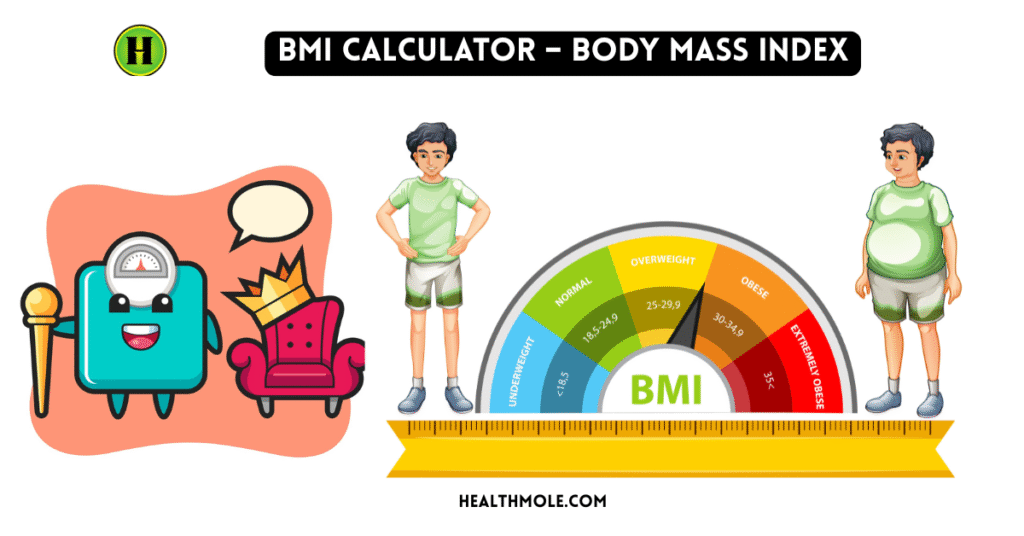How to Lower Body Mass Index? Most Powerful BMI Calculator

Before knowing how to Lower Body Mass Index? Let’s know about BMI and how it works for a unique individual on this planet.
Body Mass Index (BMI) is one of the simplest and most widely accepted ways to understand whether your body weight is healthy for your height. BMI is not just a number. It is a science-backed screening method used by doctors, global health organizations, medical researchers, and government health policies worldwide to quickly determine whether someone’s weight falls within the underweight, normal, overweight risk zone, or obesity categories.
In simple language, BMI tells you how balanced your weight is according to your height. When you use a BMI calculator, you are not just checking weight; you are checking your health risk direction. A healthy, normal BMI range is considered the safest zone for long-term health, low disease risk, balanced metabolism, good heart function, and potential for a long lifespan. This is why almost every health journal, public health body, fitness coach, clinical dietitian, and weight loss specialist still uses BMI as a starting point indicator.
Why BMI Calculator is Still Important Today
BMI is one of the fastest ways to detect potential weight problems early. Even though modern body composition tools exist like body fat scanners, DEXA scans, bioimpedance, muscle mass scanners etc — BMI still remains the single universal tool accepted globally. It gives a quick and reliable estimation of healthy body weight category without expensive equipment.
Doctors prefer BMI first because:
- It can be calculated instantly
- It needs only height + weight
- It correlates strongly with major lifestyle diseases
- It gives a predictable health risk direction
BMI is especially useful for people who want a starting point to improve lifestyle, diet planning, calorie management, weight goals, fitness structure, and long-term preventive healthcare.
Why Normal BMI Range Matters More Than People Realize
Normal BMI range is not just a medically defined range — it represents the zone where the human body functions best internally. People inside the normal BMI zone generally have:
- Better heart health
- Better insulin sensitivity
- Better blood pressure control
- Lower inflammatory load
- Better hormone balance
- Reduced joint stress
- Longer lifespan expectation
Being normal BMI gives your body a metabolic advantage and protects your future health. Overweight gradually builds higher risk. Underweight gradually destroys your immune and muscle support system. Normal is the safe center.
How To Calculate BMI (Formula Section)
BMI calculation is extremely simple because it needs only weight and height.


When someone explores and uses a BMI calculator online, these formulas are used to produce results. The reason BMI became so universal is that this single formula is accepted worldwide by medical science, fitness professionals, nutritionists, and public health guidelines.
What is Considered a Normal BMI Range?
The normal BMI range is the range where your body weight is absolutely proportionate to your height and considered healthy for long-term health and disease prevention.
Normal BMI Range as standard: 18.5 to 24.9
But this may slightly vary by region because genetics, lifestyle, ethnicity, diet pattern, metabolism and chronic disease risk changes by population.
That is why we must show multiple versions of the normal BMI reference. like Army BMI Calculator
BMI Calculator – Body Mass Index Normal
BMI Calculator for Kids, BMI Calculator for Men, BMI Calculator for Teenagers, Military BMI Calculator, Military BMI Calculator, BMI Calculator for Women, Body Mass Index Converter, BMI Calculator for Old Aged, Geriatric BMI Calculator
Global Normal BMI Chart Comparison
WHO Standard Normal BMI Table
| Category | BMI Range |
|---|---|
| Underweight | Below 18.5 |
| Normal Weight | 18.5 to 24.9 |
| Overweight | 25 to 29.9 |
| Obesity | 30 or above |
Body Mass Index Asia
| Category | BMI Range |
|---|---|
| Underweight | Below 18.5 |
| Normal Weight | 18.5 to 22.9 |
| Overweight | 23 to 24.9 |
| Obesity | 25 or above |
Asian risk is higher for metabolic disease even at lower BMI, so their normal range is tighter.
Indian Normal BMI Guidance (More Clinical Public Health Oriented)
| Category | BMI Range |
|---|---|
| Underweight | Below 18.5 |
| Normal Weight | 19 to 22.9 |
| Overweight Risk | 23 to 24.9 |
| Obesity | 25 or above |
The Great Indian normal BMI range is slightly shifted toward the lower side because Indians have a higher visceral fat storage tendency even at lower BMI, which increases diabetes risk, heart risk, and metabolic syndrome cases more commonly when observed.
US CDC Normal BMI Table (Often used in American clinical references)
| Category | BMI Range |
|---|---|
| Underweight | < 18.5 |
| Normal | 18.5 to 24.9 |
| Overweight | 25.0 to 29.9 |
| Obesity | ≥ 30.0 |
How to Lower Your Body Mass Index & Improve BMI Safely?
Everybody wants to know how to reduce body mass index, but some fail to understand the procedure. Here comes Healthmole Media to enhance your ability to reduce body mass index and keep you healthier. You must slowly lower your BMI with sustainable lifestyle changes, so that fat loss happens without muscle loss. The goal is not just to reduce scale weight but to improve your health quality.
Steps to Start Today
- Add at least 40 to 60 minutes of walking to youe daily routine.
- Drink more water and stay hydrated always
- Reduce sugary drinks and deep-fried items which are harmful to your health.
- Always Eat more homemade food items and less outside junk food to control the graph.
- Sleeping 7–8 hours minimum every night is mandatory for everybody.
- Avoid stress eating and emotional eating. Instead, practice silence while eating.
- Increase protein food intake. So that you feel full longer.
Small improvements done every day are more powerful than extreme big temporary efforts.
Best and Safe Ways to Lower your Body Mass Index
- Eat mild calorie-deficient food daily, not an extreme starvation diet.
- Increase protein intake daily to protect your muscle mass.
- Strength train a minimum of three to four days weekly to keep your muscles in control.
- Walk atleast eight to twelve thousand steps every day for better metabolism..
- Avoid consuming sugary drinks and fast food items completely.
- Eat more leafy and iron-rich vegetables and increase natural dietary fiber.
- Control your inner emotional snacking and reduce stress eating.
- Add simple cardio like running, cycling, or swimming to your routine.
These above suggested steps will push your limits to control your BMI standards to a normal, healthy level.
Which Normal BMI Range Should You Follow?
Use this simple rule:
- If you live in India or Asian countries → follow Asian/Indian BMI reference
- If you live in Western countries → WHO or US CDC reference is fine to follow
- Always aim for the center of normal range, not just border of normal
Because staying in the center of normal keeps a safety margin in BMI
.
What Happens When BMI is Below Normal?
Low BMI health risks include:
- Lower immunity
- Higher infection risk
- Nutrient deficiencies
- Weak bones / lower bone mineral density
- Low muscle mass & fatigue
- Poor hormone balance
- Higher hospitalization risk during illness
Underweight condition needs attention because it silently weakens body systems.
What Happens When BMI is Above Normal?
High BMI health risks include:
- Diabetes Type 2 risk increases
- Heart disease / hypertension
- High cholesterol buildup
- Liver fat accumulation
- Sleep apnea
- Joint pain due to mechanical stress
- Higher inflammation inside body
That is why overweight and obesity are always considered as “slow lifestyle diseases.”
A normal BMI range protects your future health.
Why Normal BMI Protects Future Health
When your weight is balanced for your height:
- Your metabolism burns calories efficiently
- Your heart works smoothly
- Your joints carry load comfortably
- Your hormones maintain balance
- Your sleep quality stays stable
- Your energy stays consistent every day
Normal BMI is not only a number > it is a long-term investment in future health.
Factors That Influence BMI Change
- Eating habits
- Sedentary lifestyle
- Excessive junk food
- Lack of physical activity
- Muscle mass loss
- Poor sleep schedule
- Stress eating
- Genetic body type
BMI is dynamic. It can be corrected slowly and steadily with correct lifestyle adjustments.
How to Improve BMI Safely and Naturally
Improving BMI is not about rushing weight change. Our human body responds to it”s best when transformation is slow, steady, and consistent. Small daily improvements produce bigger and long-term results than aggressive short-term actions does. When you focus on eating good-quality foods, staying physically active,as suggested above your BMI begins to move toward the normal healthy range automatically, without harming metabolism you can check later by coming back to Healthmole Media..
FAQs
It is a tool that helps you calculate your Body Mass Index using height and weight.
Anyone above age 18 can use it to understand weight category.
Because it helps detect weight-related health risk early before disease starts.
Formula is same worldwide but normal range may vary slightly by region.
No, BMI is an estimate. For exact fat you need body composition testing.
Normal BMI for most adults is between 18.5 and 24.9.
Because Asian population develops metabolic risk at lower BMI levels.
Yes. High muscle mass can elevate BMI even if body fat is low.
No. Use BMI + lifestyle evaluation + waist measurement for better clarity.
Ranges are similar but fat distribution patterns are different biologically.
Yes. Stress increases emotional eating and hormone imbalance.
Yes. Lack of sleep increases hunger hormones and junk cravings.
Hydration helps metabolism, digestion, and appetite control.
Fast weight loss harms muscles. Slow and steady reduction is safest.
Once every 2–4 weeks is enough.
Yes. BMI changes with weight changes which change monthly.
BMI is more medically meaningful because it measures weight-to-height.
Overweight and obesity BMI levels increase diabetes type-2 risk.
Yes but body composition changes with age must be considered.
Athletes need body fat confirmation because muscle increases BMI.
Yes. Late night eating increases fat storage tendency.
Natural whole fruits are better than juices because fiber helps fullness.
Yes. BMI is a simple progress tracking number.
Indirectly yes. Normal BMI reduces risk of lifestyle-related diseases.
Aim mid-normal. Center zone is the most stable and safe long-term.
Conclusion finally
The Normal BMI range represents the most stable health zone for the human body. BMI Calculation is simple, universal, medically recognized everywhere, and strongly connected with disease prevention. When you maintain your BMI in normal range, you reduce risks of heart disease, diabetes, high blood pressure, joint problems, sleep issues, inflammation, and metabolic disorders.
BMI Calculator gives a quick snapshot of whether your current weight is correct for your height. Once you know the number, you can apply small lifestyle improvements daily and prevent long-term complications. BMI is not a punishment tool — it is an awareness tool that helps people take control of their health in the easiest possible way.
Normal BMI is the longest living zone. Protect it like an asset.
References
- Adult BMI Calculator – Centers for Disease Control and Prevention (CDC)
- BMI-for-age (5-19 years) – World Health Organization (WHO)
- Body Mass Index (BMI) – American Cancer Society
- BMI Classification Percentile and Cut Off Points – StatPearls / NCBI
- BMI Calculator – Harvard Health Publishing
Healthmole Media
Always a helping hand rises where a heart deserves


